Jaltomata aspera (R. & P.) Mione |
Peru |
revised 2 February 2022 |
The information on this page may be cited as a communication with professor Thomas Mione, Central Connecticut State University, Biology Department, Copernicus Hall, 1615 Stanley Street, New Britain, CT 06050-4010 USA, and Segundo Leiva G., Universidad Privada Antenor Orrego, Av. América Sur 3145, Casilla postal 1075, Trujillo, Peru |
Novon 2: 383-384. 1992. |
Link to Jaltomata homepage |
Links to Jaltomata species having edible fruit including this species, and to local names including for this species |
Link to the Jaltomata of the Peruvian lomas formations |
| Figure 1, above. Flower of Jaltomata aspera. Peru, Department Lima (S. Leiva G., R. Olmstead & N. Refulio 4545, photo by Segundo Leiva G.) |
Figure 2, above. Peru, Department Lima (S. Leiva G. et al 4545, photo by Segundo Leiva G.) |
Figure 3, above. S. Leiva G. et al. 4545, photo by Segundo Leiva G. |
Figure 4, above. This photo was generously provided by Dr. Graciela Vilcapoma S. and Arturo Granda P. (Vilcapoma S. & Granda P. 4326) |
Figure 5, above. Note how the style is widest at base and gradually narrows from proximal to distal, and how the stigma is punctiform (about as wide as the distal end of the style). Anthers are undehisced. The corona is evident in this photo (a bowl of tissue on which nectar pools). Mione, Leiva & Yacher 615 after flowers were stored in 70% ethanol for a few years, photo by T. Mione |
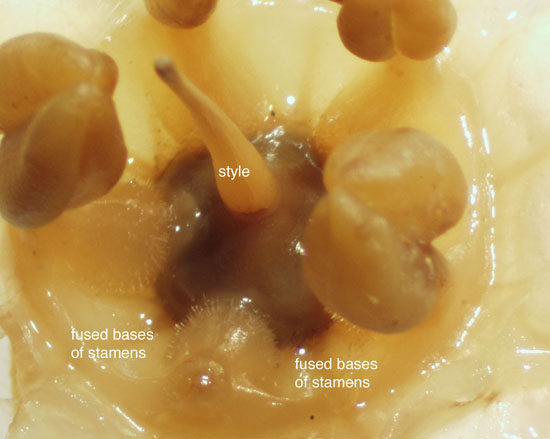 |
|
| Figure 6, above. Anther and distal portion of filament of Jaltomata aspera. Unlike other Jaltomata species more of the filament shows in dorsal view (right) than in ventral view (left). Left: ventral view of anther (view from style); right: dorsal view (back of anther); units vertically along right are mm, flowers were stored in 70% ethanol then photographed by Thomas Mione; Mione, Leiva & Yacher 615. | Figure 7, above. One anther was removed to show the corona (bowl of tissue on which nectar pools). At the center of the photo is the ovary of the flower, below the style. (Mione, Leiva & Yacher 615 after flowers were stored in 70% ethanol for a few years, photos by Thomas Mione) |
| Character | Description | Figures on this page |
Habit & Height |
This species was described as herbaceous in its protologue, but has also been described as suffrutescent (in the protologue of Saracha lacrima-virginis and on a specimen label [Vilcapoma 2950 There appears to be no correlation between herbaceous/suffrutescent and lomas vs. Andes. 20 - 58 cm | |
Branches, young |
pubescent, the hairs short, rigid, glandless | figures 1 |
older |
figure | |
Leaves, size |
figure | |
| shape | ||
| hairs | pubescent to glabrate, the hairs short, rigid, glandless |
|
| petiole | ||
Inflorescence |
Flowers almost always solitary | figure |
peduncle |
figure | |
pedicel |
Pedicels articulated (one can see both a pedicel and a peduncle); |
figure |
Calyx at flowering |
green, nearly planar | figure |
| at fruit maturity | figure | |
Corolla color |
greenish-yellow or yellow-green, lacking 5 pairs of maculae | figure |
shape and size |
very broadly campanulate, to 42 mm across | figure |
lobes/lobules |
5-lobed (no lobules, notch at lobule's location) | figure |
hairs
|
||
| no | ||
Stamen length |
12 - 14 mm |
figures |
| filaments | glabrous except for base, the base pubesent | |
| anther color | ||
| anther size | 3.5 - 4.5 mm | figure |
| anther mucronate/mucronulate | not mucronate | |
| insertion of filament into anther | Basifixed (not lower ventral face). Filament shows when looking at back of anther (this species is an exception to the norm: nearly all Jaltomata species show more of the filament in the ventral view of anther). |
figure |
| anthers of a flower open simultaneously? | ||
| pollen quantity per flower | 1,300,000 |
Mione et al. 615, count by Emmett P. Varricchio, flower collected in Peru; the count from 1 anther was multiplied by 5, thus this datum was collected in a manner different from the pollen quantity data of other Jaltomata species in this web site |
| pollen grain size | µm, µm |
|
| corona | Yes | figures 1 |
Stigma |
punctiform | figure |
Style |
widest at base and gradually narrowing toward apex, 6.5 - 8 mm long in lomas, 9.5 - 12 mm long in Andes. | |
Ovary |
||
Ovules per ovary |
||
Nectar |
red | figure |
| Herkogamy | yes, see figure 1 | figure |
| Protogyny | no data |
|
Fruit color (at maturity) |
white (Macbride 1962); orange (Granda 926) |
figure |
| fruit size | ||
Seeds per fruit |
||
Seed Size |
||
Chromosome number |
no data |
|
Growability in Connecticut, USA |
||
How long does it take from flower to ripe fruit? |
no data |
|
Self-Compatible? |
no data |
|
Seed Germination |
||
| Character | Description of Jaltomata aspera |
Low elevation populations grow below 600 m of elevation, while high elevation populations grow above 1,380 m of elevation. The low elevation and the high elevation populations of J. aspera flower at different times of the year, and so are reproductively isolated. And, the Andean (higher elevation) plants may have longer styles. If the low elevation and high elevation populations are considered distinct species Saracha urbaniana would be transferred to Jaltomata as J. urbaniana (Bitter & Dammer). The higher elevation specimens would then all go by this name. And the low elevation (lomas) specimens would continue to be known as J. aspera. According to Arturo Granda Paucar (personal communication, year 2001) this phenomenon, low elevation (lomas) and high elevation populations being considered conspecific, is found in "several species of different families: Hyptis sidifolia (Lamiaceae) grows and blooms with the higher population of J. aspera in the vicinity of Cata, but also is found in Lomas formation along with the lower population of J. aspera. Another example is Ipomoea nationis (Convolvulaceae)...with similar blooming time." |
| The three species of section Modillonia are herbaceous, have solitary flowers, a 5-lobed corolla, a corona (figure 7 of this webpage), lack radial thickenings, have basifixed anthers (other species of this genus have the filament inserted into the lower ventral face of the anther), a stigma about as wide as the top of the style (stigma punctiform, not capitate), grow in Peru and produce copious red-orange nectar. A table comparing the species of Jaltomata section Modillonia can be seen on the J. quipuscoae webpage. |
Peru, Department Lima. In the lomas formation:
Elevation 152 to 600 m, flowering September, October & November. |
| Department | Province | Locality | elevation m | habitat | date | collector |
|---|---|---|---|---|---|---|
| Lima | Lima | TYPE: Hills of Lima Amancaes. Amancaes (figures 16 - 19) is located at 12 01' 00" S, 77 02' 00" W |
These hills are under 500 m from labels of conspecific collections made in these hills (elevation not mentioned in protologue) | Amancaes is loma-formation (not mentioned in protologue) | "flowering in Oct and Nov" is stated in protologue, so collections were almost certainly made during these months | Ruíz López & Pavón s.n. (not seen, Mione corresponded with MA in 1998 and they replied "not found in our collections") |
| Lima | Lima | type of Saracha lacrima-virginis, Amancaes | 200-400 |
loma-formation, rocky area | 19 Oct 1902 | Weberbauer 1587 |
| Lima | Lima | Amancaes | 200-300 |
loma-formation | Sep 1909 | Weberbauer 5246a (F, US) |
| Lima | Lima | near Lima | no data |
presumably Lomas | 1862 | W. Nation s. n. (K) |
| Lima | Lima | Hills of Mongomarca | 500 |
Loma-Formation | Sep 1909 | Weberbauer 5235 (US) |
| Lima | Lima | type of Saracha ciliata Miers, valley of Lima | no data
|
presumably lomas | looks like "July & Aug" on type specimen label | Mathews 834 (K) |
| Lima | Lima | San Geronimo | 152 |
rocky hillside | 19 Sept 1923 | J. F. Macbride 5912 (F) |
| Lima | Lima | Lima | no data |
no data | Sep 1932 | D. Stafford K.35 (K) |
| Lima | Lima | Amancaes | 300 | loma-formation | 25 Aug 1946 | J. Soukup 3124 (US) |
| Lima | Lima | Amancaes | 300 - 600 | loma-formation | 6 Sep 1950 | C. Vargas C. 9649 (CUZ) |
| Lima | Cañete | Lomas de Asia | no data |
no data | 14 October 1995 | G. Vilcapoma S. and A. Granda P. 4326 (Mione has seen photo but not herbarium specimen) |
| Lima | Canta | Arriba de Apán, camino a Puruchuco | 1,700 |
monte caducifolio con veg. herbácea | 21 Mar 1994 | G. Vilcapoma S. 2950 (MOL) |
| Lima | Canta | Apán, camino a Puruchuco | 1,600 |
ladera pedregosa con monte caducifolio | 26 Mar 1993 | Granda 926 |
| Lima | Canta | Apán, camino a Puruchuco | 2,550 |
ladera pedregosa con monte caducifolio | 2 Apr 1994 | A. Granda & J. Alegría 1254 |
| Lima | Huarochirí | km 73 of highway from Lima to La Oroya | 2,290 |
open sun, slope, with Carica candicans, Lycianthes sp., and Schinus molle; terreno xerofitico, arenos | 17 Jan 1998 | T. Mione, S. Leiva G. & L. Yacher 615 S. Leiva G., T. Mione, & L. Yacher 2130 |
| Lima | Huarochirí | Santa Eulalia-Callahuanca | 1,580 |
no data | 14 Mar 2009 | S. Leiva G., R. Olmstead & N. Refulio 4545 (HAO) |
| Lima | Huarochirí | valley of Rio Rimac, near Lima-Oroya, highway at km 70 east of Lima | 1,800 |
dry open hillside, granite soil, with cacti | 15-22 Mar 1942 | Goodspeed & Metcalf 30248 (MO, US) |
| Lima | Huarochirí | type of Saracha urbaniana, above San Bartolomé (Lima to Oroya R. R.) | 1,600-1,700 |
rocky slopes with not very dense xerophytic vegetation mainly cacti and shrubs that are green when it rains | 27 Mar 1910 | A. Weberbauer 5262 (US)(photo NY) |
| "We all remained in Lima until the 19th of December [1781], drying and describing the plants collected on the way from Huaura to Lima, and describing those I found on the outskirts of the capital in gardens and orchards. Among these, I described the following. Jaltomata aspera (as Atropa aspera, page 194) ..." |
Jaltomata aspera (Ruiz & Pavón) Mione. Basionym: Atropa aspera Ruiz and Pavón, Flora Peruviana,
et chilensis 2: 45. 1799. Ulticona aspera (Ruiz & Pavón) Raf., Sylva Telluriana 55. 1838. Hebecladus asperus (Ruiz & Pavón) Miers,
London J. Bot. 4: 322. 1845. |
Figure 8, above. Unripe fruit (Peru, Department Lima, S. Leiva G., R. Olmstead & N. Refulio 4545, photo by Segundo Leiva G.) |
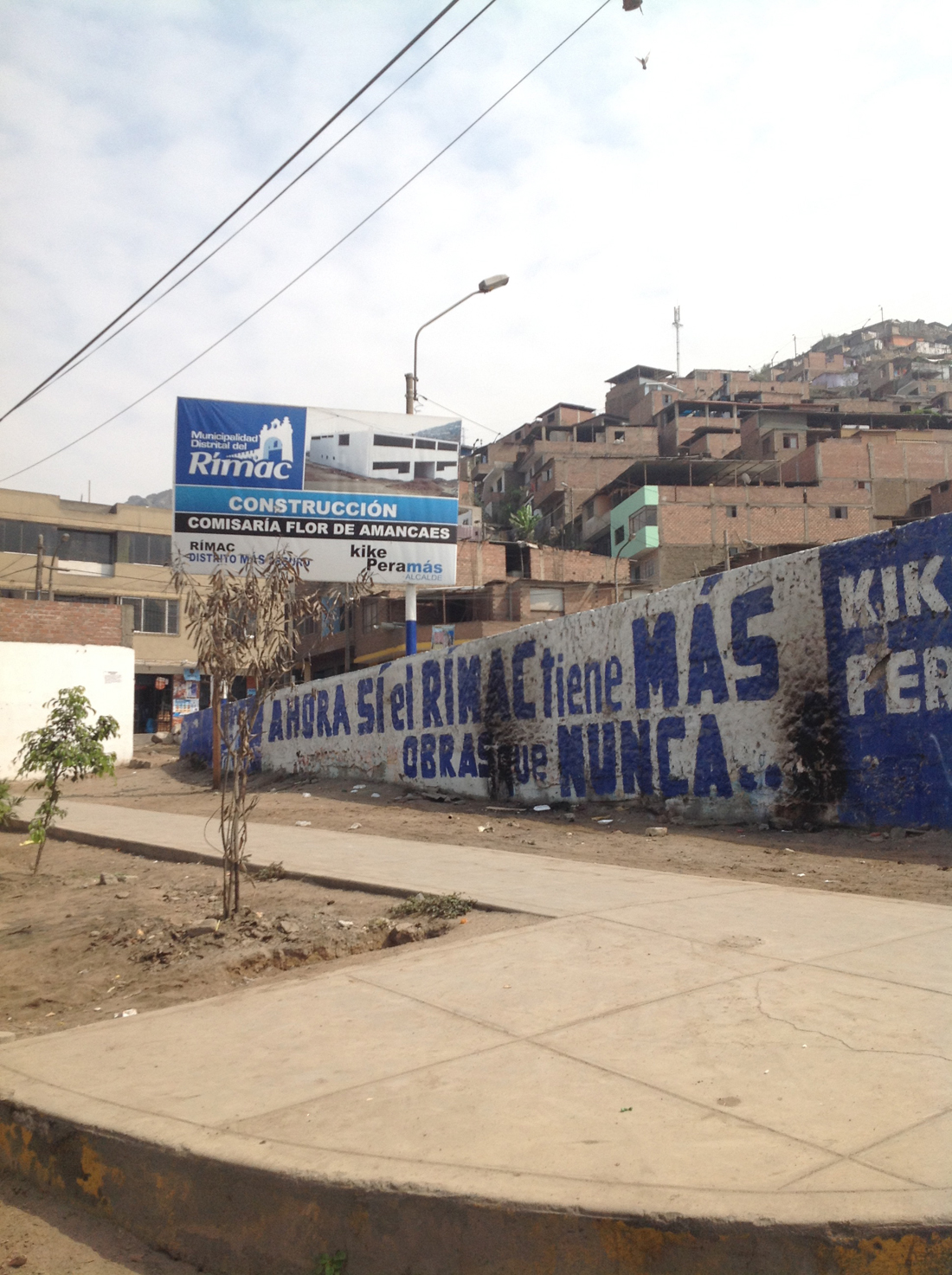 |
Figure 9, above. The type locality of Jaltomata aspera is Amancaes, Hills of Lima. This is Amancaes in February of 2014. Photo by Leon Yacher.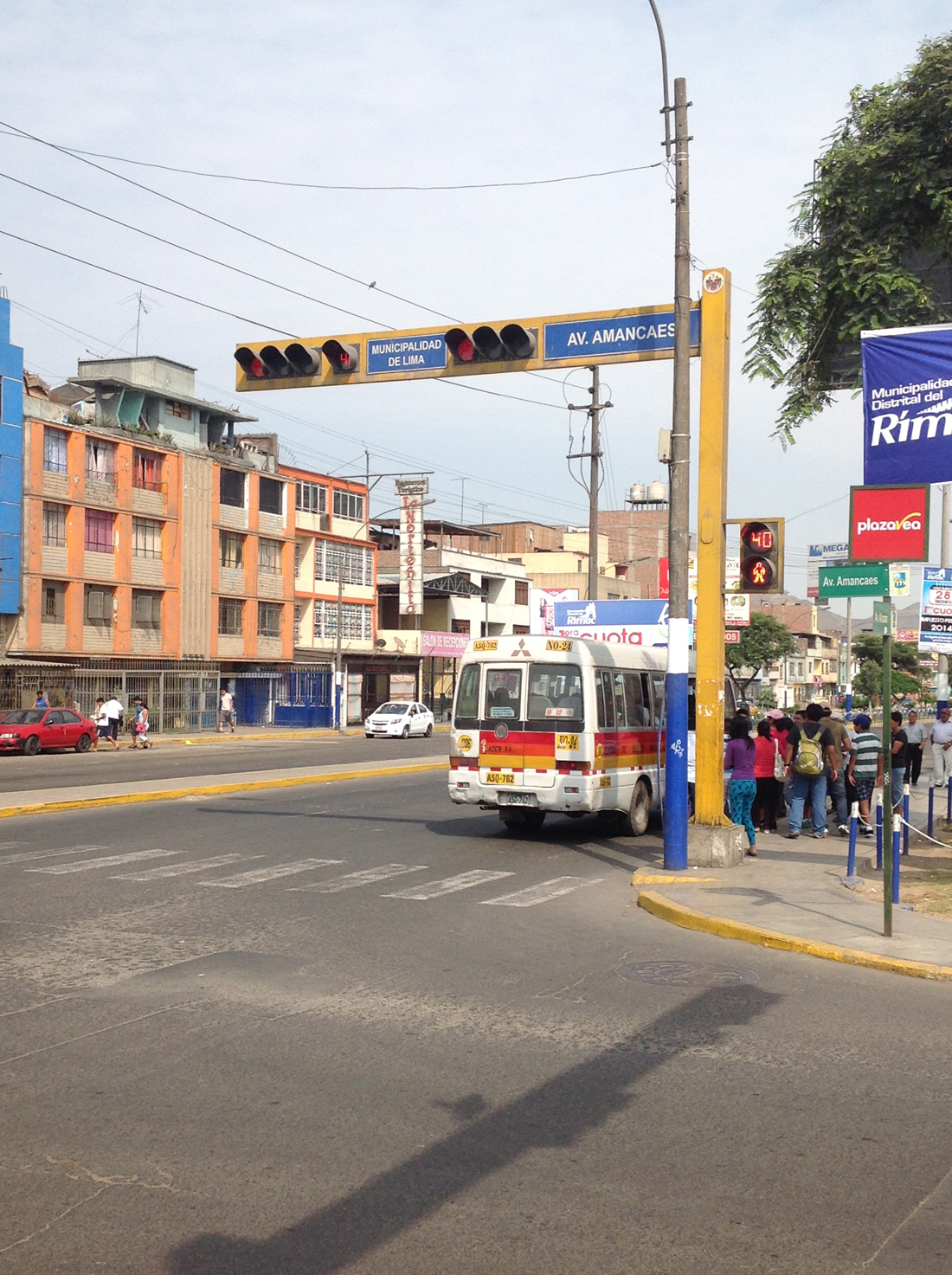 |
| Figure 10, above. The type locality of Jaltomata aspera is Amancaes, Hills of Lima. This is Amancaes or near Amancaes in February of 2014. Photo by Leon Yacher. |
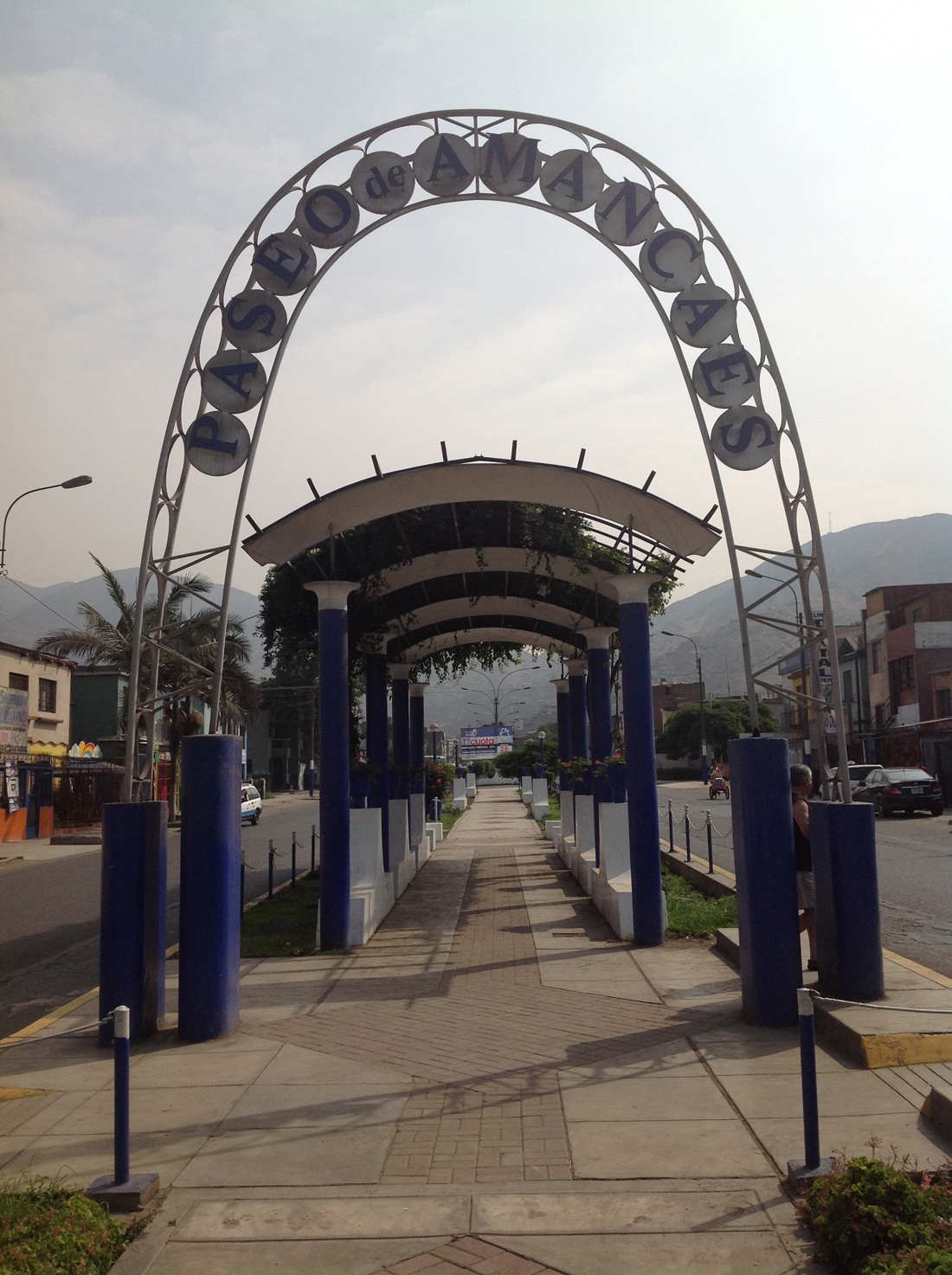 |
| Figure 11, above. The type locality of Jaltomata aspera is Amancaes, Hills of Lima. This is Amancaes in February of 2014. Photo by Leon Yacher. |
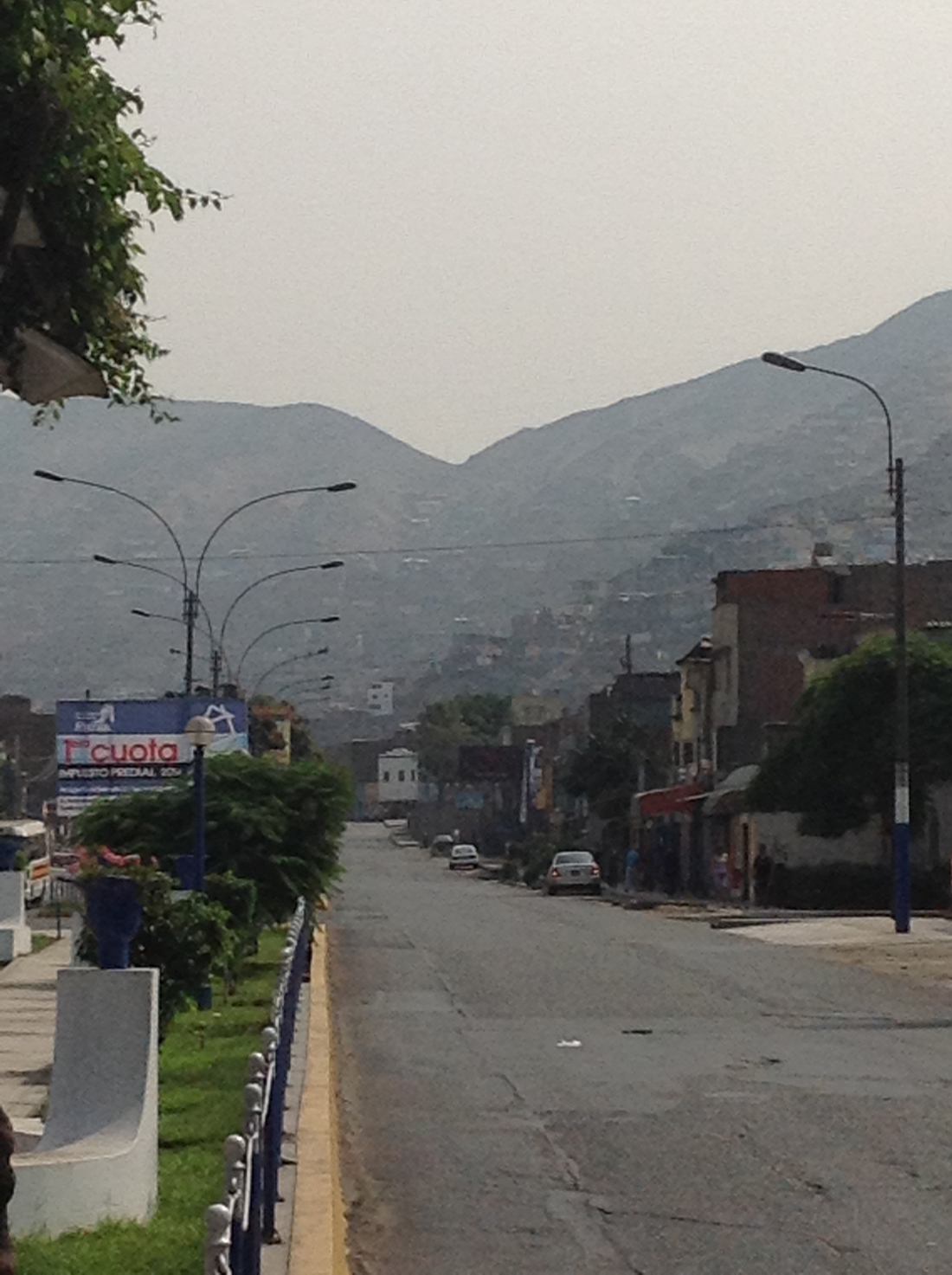 |
| Figure 12. The type locality of Jaltomata aspera is Amancaes, Hills of Lima. This is Amancaes in February of 2014. Photo by Leon Yacher. |